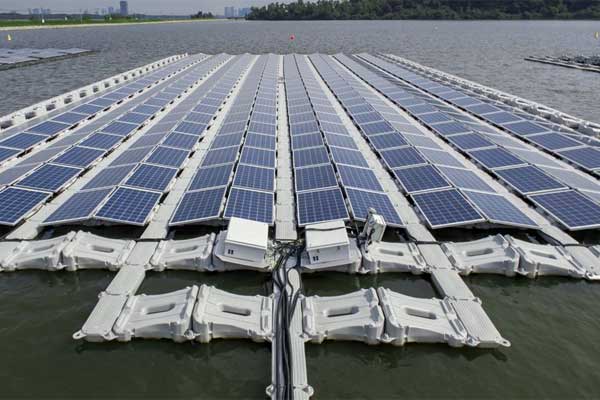Floating solar also referred to as a floating solar array or floating solar farm, refers to an array of photovoltaic panels on a structure that floats on a body of water, typically a reservoir or lake.
While this technology is unlikely to replace the solar panels on your home’s roof in the next year or so, it offers some important benefits to a world seeking to go greener.
What Are They?
Structurally, a floating solar panel is an array of photovoltaic (PV) panels attached to a structure, typically a raft. It floats in a body of water, most commonly on a lake or on a reservoir. A collection of these panels can turn a small body of water into a solar power plant.
Rafts that support floating solar panels typically have walkways that give workers access to perform maintenance. Since the panels are in use in, as well as around, water, any materials utilized to construct them must be compatible with a watery environment. Although the system typically relies on onshore inverters, wires in the arrays have to be submersible. Systems compatible with the ocean are still in the works due to potential damage from robust waves and sea salt.
A number of design elements must provide protection from the elements. Floating solar panel arrays also have to be strong enough to avoid going adrift. When placement presumes that the water might freeze, the design of the anchoring structure has to permit panels to rest atop any ice that forms.
A number of countries have embraced this technology, and the demand is growing. Floating solar panels have already been in use in Japan, France, Indonesia, Singapore, and the United Kingdom. China is currently home to two-thirds of the panels in the world.
The Benefits
The use of floating solar panels has a number of economic benefits when compared to relying on traditional solar panels. Floaters are growing in popularity in areas that have limited land space, such as islands, to use for capturing solar energy. Underutilized areas such as reservoirs can become very productive power stations. The possibilities are endless — local governments can take advantage of this technology, but so can commercial enterprises near bodies of water that would like to become more environmentally conscious and efficient.
A relatively low lease price and installation cost combine to raise the return on the investment required to construct a project. The panel manufacturing process has been streamlined to incur low production costs. As a result, system prices are becoming increasingly competitive. Systems easily adapt to any electrical configuration. It’s also possible to select low to high generation of power.
Most floating systems also perform better than solar panels installed on land. This is because evaporating water keeps them cooler. The cooler temperature allows more efficient operation. When the design also includes shielding the water from the sun, evaporation drops even more.
Global, as well as local environmental benefits of this type of renewable energy, are particularly appealing. The major ones include:
- Installation requires no heavy equipment or tools
- Reservoir placement assures no disruption to fish or birds
- All construction materials are recyclable
- The lack of excavation means no water quality impact
- Reduced water evaporation saves water used for drinking and irrigation
- Panels shield water from the sun and slow the growth of algae
Are floating solar panels in your future? If you live in California, you might benefit from them sooner than in other states. A Sonoma County project has been designed for use at a wastewater treatment plant.
Floating solar panels are also scheduled for use on the Olivenhain Reservoir in San Diego County.
Experts predict that they will definitely be a boon for the drought-prone state. Eventually, that could result in a dip in what you pay for energy.











Comments